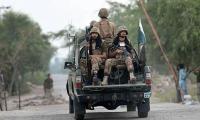The writer is former adviser,Ministry of Finance.
We live in uncertain times. The last two years have been tumultuous for citizens globally. A pandemic for which there was no playbook, followed by a fragile economic recovery, recently overshadowed by geo-political turmoil and a resultant inflation shock, has left many families struggling to make ends meet. Higher fuel, food and shipping costs continue to increase prices and stretch household budgets.
In Pakistan’s case, weak economic fundamentals, global price pass-through with devaluation enhancing the price effect, and expansionary fiscal stance, have all exacerbated prices. Inflation touched a high of 12.7 percent YoY in March 2022. Nine month average inflation is in double digits at 10.77 percent. Inflation is likely to remain elevated in 2022. Consequently, the State Bank of Pakistan raised the discount rate to 9.75 percent on March 8, 2022. This rise may negatively impact the healthy private-sector credit off-take seen in FY22 of about Rs874.3 billion as opposed to Rs403.6 billion last year, with consequences on slowing economic growth.
The country’s economy’s external economic indicators are more concerning. Current account deficit is now estimated to widen to an untenable level of 5-6 percent of GDP in FY22 – twice as high as the initial forecast of 2.6 percent and even surpassing the recent forecast of 4 percent. A widening current account deficit continues to erode Pakistan’s largely borrowed foreign exchange reserves. State Bank reserves have declined to $12.05 billion on March 25, 2022 from a high of $20.1 billion in August 2021 – a hefty fall of 40 percent. Reserves now barely cover two months of Pakistan’s import needs. Our economy may fast be approaching an uncomfortable balance-of-payment position.
Foreign direct investment remains stagnant at an unimpressive level of $1.26 billion in 8MFY22. Foreign private portfolio investment has witnessed a net outflow of $314.6 million during 8MFY2022. Foreign public portfolio investment had a net inflow of $904.9 million in 8MFY22 aided by an inflow of $1.0 billion of Pakistan International Sukuk bond. The Sukuk carries an interest rate of 7.95 percent – the highest return Pakistan has ever paid on an Islamic bond.
The Federal Board of Revenue’s (FBR) tax collection has been encouraging in FY22 after three years of low growth. The FBR has collected Rs4,382 billion from July-March 2022 against Rs3,394 billion in the same period last year – a growth of 29.1 percent. It is prudent to mention that the bulk of the FBR revenue growth is dependent on imports, which grew by 50 percent from $32.1 to $47.9 billion in 8MFY22.
With monetary tightening to slow the economy, a weakening rupee acting as a buffer to slow imports, the rise in revenues may not sustain the same growth momentum as seen in 9MFY22. Collection of Rs575 billion in March is about 5 percent shy of the Rs604 billion target. The FBR also missed its collection target in three out of the last four months. Non-tax revenue (NTR) is a substantial resource spinner for the budget, estimated at Rs2,080 billion for FY22. NTR collections at Rs783 billion for the first six months of FY22 are 16.7 percent lower than the same period last year – not an encouraging picture.
Budget deficit in the first seven months of FY22 has risen to a worrisome level of Rs1,862 billion (2.9 percent of GDP) from Rs1,309 billion (2.4 percent of GDP) in FY21 – a mammoth increase of 42 percent. This requires higher domestic and international borrowing and puts further pressure on rising inflation.
Given the above challenging economic picture and a fluid political climate, astute economic management and near-perfect calibration of monetary and fiscal policies in the near term is critical. Let us outline some practical steps.
First, it is wise for Pakistan to complete the on-going programme with the International Monetary Fund (IMF). External financing needs have risen to near $32 billion for FY22 and $35 billion for FY23. The continuous depletion of SBP reserves and the unsettling devaluation in the exchange rate is a ramification of the economic frailty that exists in the country. Restoring confidence requires successful closure of the seventh review with the IMF. A note of caution: if the talks with the IMF were to remain inconclusive, it could raise both local and foreign borrowing costs and hurt Pakistan’s sovereign credit ratings. One can’t stress enough our preparation in data accumulation, economic modelling and policy prescription that will get us across the bridge with the IMF on favourable terms.
Second, the IMF programme review closure is time bound. Being in an IMF programme requires consultation on the contours of Budget 2023 with the IMF. Budget 2023 needs to be prepared considering available financing options, encompassing the needed repair of expenditure side as current expenditure has swelled to Rs7,523 billion in the past three years. The burgeoning pensions of the federal government to Rs480 billion and rising mark-up payments near Rs3,073 billion remain an unfinished reform agenda.
Third, we must, for the medium term, put up a framework which stabilises and then reduces gross and net debt as a share of the economy. Pakistan’s accumulated debt and liabilities of Rs29.88 billion in FY18, have markedly risen to an uncomfortable level of Rs51.72 billion in less than four years. External debt has increased to $130.6 billion as of December 31, 2021 from $92 billion in 2018.
We must target a budget balance, on average, over the course of an economic cycle that is consistent with reducing the debt growth. This can be achieved by: i) managing expenditure growth; ii) supporting sustainable, progressive and simple tax burden by bringing the retail sector into the tax net and ensuring property taxes, agricultural income tax, capital gains tax and inheritance tax form part of mainstream taxation; iii) using the government’s financial resources to support agriculture productivity; and iv) enhancing investments in soft infrastructure that build a productive economy.
Lastly, managing inflation, especially ensuring vigilant supply-side monitoring of key perishable and non-perishable food items in the coming months, is crucial. Initiatives should focus on reducing food inflation as it erodes the buying power of the vulnerable and urban middle-class. This is the best relief for citizens. Beyond interest-rate hikes, much more can be done. Our goal must be to manage the supply of cheaper fuels, improve performance of competitive markets, ensure that there is no undervaluation of the rupee, and limit the rate of monetary expansion to a low double-digit rate. In the medium term, correcting the fundamentals is a sound way to manage inflation. This is all hard work.
Policymakers have to be realistic about our growing challenges. Pakistan’s structural reform agenda must be articulated in an economic reconstruction plan, and must remove the brakes on growth. The nation must believe that we are fundamentally altering the structure of Pakistan’s economy even if by a small margin – through lowering barriers to entry, broadening ownership patterns and lowering the cost of living and doing business. The task at hand is indeed daunting.
Email: khaqanhnajeeb@gmail.com
Twitter: @KhaqanNajeeb
Historically, rise and fall of many empires have been directly linked to social justice
This classification was used to distinguish these indigenous groups from others after their conversion to Islam
Unesco says, such education is in crisis because 37% of children worldwide lack this right
Impact of these reforms is evident not only in public discourse but also in letters and grievances
We also have cases where people wait for years just to become actual citizens
Trump announces $500bn investment to build AI infrastructure and secure edge over international competitors







